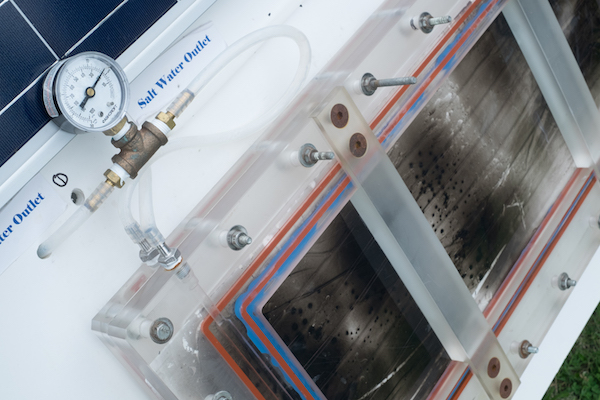
[Image above] Credit: Jeff Fitlow; Rice University
Water is a resource those of us in first-world countries tend to take for granted. Did you know nearly 800 million people in the world don’t have access to clean and safe water?
We recently reported on a water filtration method that uses ceramic tubes with an inner nanofiltration membrane to produce clean drinking water from wastewater. And prior to that, we learned about research involving tiny reusable ceramic sponges that offered the possibilities of purifying water.
But what if we could harness the power of the sun to deliver clean water to the many countries that need it?
Now, the Center for Nanotechnology Enabled Water Treatment (NEWT) at Rice University has successfully tested a new technology for purifying water that uses a desalination method consisting of membrane distillation technology and nanophotonics.
NEWT is a Houston-based research center, supported by grants from the National Science Foundation, with a mission of using nanotechnology to develop cost-effective clean water systems.
Membrane distillation is a process in which water vapor passes through a thin hydrophobic membrane that separates heated water from cold water. Although more energy-efficient than traditional distillation—where water is boiled to make steam—there’s still the problem of heat loss during the distilling process, so it’s not completely energy efficient. But, until now, it offers a better solution than the alternative.
Enter nanophotonics-enabled solar membrane distillation (NESMD), NEWT’s innovative method of converting sunlight to heat. Using nanoparticles created in their lab, NEWT researchers were able to generate enough steam from sunlight to power the membrane distillation process.
NEWT’s team created a membrane that includes a layer of a porous polymer infused with carbon black nanoparticles that heat the membrane’s surface when exposed to sunlight. As the scientists increased the intensity of the sunlight by concentrating it 25 times under a lens, water production increased to 17.5 kilowatts per square meter.
And that was just a small model.
Naomi Halas—Rice’s Stanley C. Moore professor of electrical and computer engineering and professor of chemistry, bioengineering, physics and astronomy, and materials science and nanoengineering and head of NEWT’s nanoresearch—says their technology can be more efficient at scale.
“It requires minimal pumping energy for optimal distillate conversion, and there are a number of ways we can further optimize the technology to make it more productive and efficient,” she says in Rice news release.

Credit: P. Dongare; Rice University
The NEWT team also successfully created a larger system—a panel of 70 x 25 cm (28 x 10 in.). Qilin Li, Rice professor of civil and environmental engineering, chemical and biomolecular engineering, and materials science and nanoengineering, envisions a mobile and modular system of panels, where organizations could use as many as needed to fulfill a specific demand for water.
“You could assemble these together, just as you would the panels in a solar farm,” she says in the release. “Depending on the water production rate you need, you could calculate how much membrane area you would need.”
NEWT’s system can “provide humanitarian aid or emergency response, and also to enable industrial wastewater reuse in remote locations, for example, in oil and gas fields—so as to make energy production more sustainable and cost-effective with regards to the water footprint,” Pedro Alvarez, NEWT director and Rice George R. Brown professor of civil and environmental engineering, says in a Rice video.
Sounds like a scalable and, more importantly, environmentally friendly way to deploy clean water to areas of the world that desperately need it.
The paper, published in Proceedings of the National Academy of Sciences of the United States of America, is “Nanophotonics-enabled solar membrane distillation for off-grid water purification” (DOI: 10.1073/pnas.1701835114).
Watch the video below to learn more about NEWT’s research.
Credit: Rice University; YouTube
